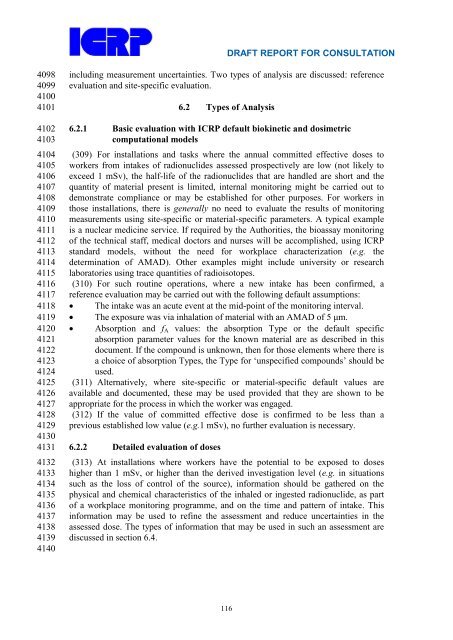Occupational Intakes of Radionuclides Part 1 - ICRP
Occupational Intakes of Radionuclides Part 1 - ICRP
Occupational Intakes of Radionuclides Part 1 - ICRP
You also want an ePaper? Increase the reach of your titles
YUMPU automatically turns print PDFs into web optimized ePapers that Google loves.
4098<br />
4099<br />
4100<br />
4101<br />
4102<br />
4103<br />
4104<br />
4105<br />
4106<br />
4107<br />
4108<br />
4109<br />
4110<br />
4111<br />
4112<br />
4113<br />
4114<br />
4115<br />
4116<br />
4117<br />
4118<br />
4119<br />
4120<br />
4121<br />
4122<br />
4123<br />
4124<br />
4125<br />
4126<br />
4127<br />
4128<br />
4129<br />
4130<br />
4131<br />
4132<br />
4133<br />
4134<br />
4135<br />
4136<br />
4137<br />
4138<br />
4139<br />
4140<br />
DRAFT REPORT FOR CONSULTATION<br />
including measurement uncertainties. Two types <strong>of</strong> analysis are discussed: reference<br />
evaluation and site-specific evaluation.<br />
6.2 Types <strong>of</strong> Analysis<br />
6.2.1 Basic evaluation with <strong>ICRP</strong> default biokinetic and dosimetric<br />
computational models<br />
(309) For installations and tasks where the annual committed effective doses to<br />
workers from intakes <strong>of</strong> radionuclides assessed prospectively are low (not likely to<br />
exceed 1 mSv), the half-life <strong>of</strong> the radionuclides that are handled are short and the<br />
quantity <strong>of</strong> material present is limited, internal monitoring might be carried out to<br />
demonstrate compliance or may be established for other purposes. For workers in<br />
those installations, there is generally no need to evaluate the results <strong>of</strong> monitoring<br />
measurements using site-specific or material-specific parameters. A typical example<br />
is a nuclear medicine service. If required by the Authorities, the bioassay monitoring<br />
<strong>of</strong> the technical staff, medical doctors and nurses will be accomplished, using <strong>ICRP</strong><br />
standard models, without the need for workplace characterization (e.g. the<br />
determination <strong>of</strong> AMAD). Other examples might include university or research<br />
laboratories using trace quantities <strong>of</strong> radioisotopes.<br />
(310) For such routine operations, where a new intake has been confirmed, a<br />
reference evaluation may be carried out with the following default assumptions:<br />
The intake was an acute event at the mid-point <strong>of</strong> the monitoring interval.<br />
The exposure was via inhalation <strong>of</strong> material with an AMAD <strong>of</strong> 5 μm.<br />
Absorption and fA values: the absorption Type or the default specific<br />
absorption parameter values for the known material are as described in this<br />
document. If the compound is unknown, then for those elements where there is<br />
a choice <strong>of</strong> absorption Types, the Type for ‘unspecified compounds’ should be<br />
used.<br />
(311) Alternatively, where site-specific or material-specific default values are<br />
available and documented, these may be used provided that they are shown to be<br />
appropriate for the process in which the worker was engaged.<br />
(312) If the value <strong>of</strong> committed effective dose is confirmed to be less than a<br />
previous established low value (e.g.1 mSv), no further evaluation is necessary.<br />
6.2.2 Detailed evaluation <strong>of</strong> doses<br />
(313) At installations where workers have the potential to be exposed to doses<br />
higher than 1 mSv, or higher than the derived investigation level (e.g. in situations<br />
such as the loss <strong>of</strong> control <strong>of</strong> the source), information should be gathered on the<br />
physical and chemical characteristics <strong>of</strong> the inhaled or ingested radionuclide, as part<br />
<strong>of</strong> a workplace monitoring programme, and on the time and pattern <strong>of</strong> intake. This<br />
information may be used to refine the assessment and reduce uncertainties in the<br />
assessed dose. The types <strong>of</strong> information that may be used in such an assessment are<br />
discussed in section 6.4.<br />
116

















